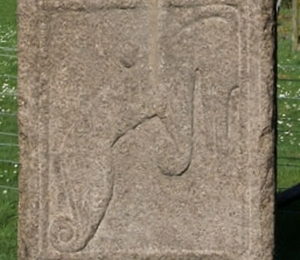Pictish beast on:
[Wikipedia]
[Google]
[Amazon]

 The Pictish Beast (sometimes Pictish Dragon or Pictish Elephant) is an artistic representation of an animal depicted on Pictish symbol stones.
The Pictish Beast (sometimes Pictish Dragon or Pictish Elephant) is an artistic representation of an animal depicted on Pictish symbol stones.
File:Martin's Stone - geograph.org.uk - 14993.jpg, St Martin's stone
File:Strathmartine castle stone.jpg, Strathmartine Castle Stone
Pictish Art And The Sea, Craig Cessford, The Heroic Age
Scottish legendary creatures Symbols on Pictish stones Scottish mythology {{Scotland-hist-stub

Design
The Pictish Beast is not easily identifiable with any real animal, but resembles aseahorse
A seahorse (also written ''sea-horse'' and ''sea horse'') is any of 46 species of small marine fish in the genus ''Hippocampus''. "Hippocampus" comes from the Ancient Greek (), itself from () meaning "horse" and () meaning "sea monster" or " ...
, especially when depicted upright. Suggestions have included a dolphin
A dolphin is an aquatic mammal within the infraorder Cetacea. Dolphin species belong to the families Delphinidae (the oceanic dolphins), Platanistidae (the Indian river dolphins), Iniidae (the New World river dolphins), Pontoporiidae (the ...
, a kelpie
A kelpie, or water kelpie (Scottish Gaelic: ''Each-Uisge''), is a shape-shifting spirit inhabiting lochs in Scottish folklore. It is usually described as a black horse-like creature, able to adopt human form. Some accounts state that the kelpi ...
(or ''each uisge
The each-uisge (, literally " water horse") is a water spirit in Scottish folklore, known as the each-uisce (anglicized as ''aughisky'' or ''ech-ushkya'') in Ireland and cabyll-ushtey on the Isle of Man. It usually takes the form of a horse, an ...
''), and even the Loch Ness Monster
The Loch Ness Monster ( gd, Uilebheist Loch Nis), affectionately known as Nessie, is a creature in Scottish folklore that is said to inhabit Loch Ness in the Scottish Highlands. It is often described as large, long-necked, and with one or mor ...
.
Recent thinking is that the Pictish Beast might be related to the design of dragonesque brooches, which were S-shaped pieces of jewelry, made from the mid-1st to the 2nd century CE, that depict double-headed animals with swirled snouts and distinctive ears. These have been found in southern Scotland and northern England. The strongest evidence for this is the presence on the Mortlach 2 stone of a symbol very similar to such a brooch, next to and in the same alignment as a Pictish Beast.
The Pictish Beast accounts for about 40% of all Pictish
Pictish is the extinct Brittonic language spoken by the Picts, the people of eastern and northern Scotland from Late Antiquity to the Early Middle Ages. Virtually no direct attestations of Pictish remain, short of a limited number of geographica ...
animal depictions, and so was likely of great importance.
The Pictish Beast is thought to have been an important figure in Pictish mythology, and possibly even a political symbol.
See also
*Celtic art
Celtic art is associated with the peoples known as Celts; those who spoke the Celtic languages in Europe from pre-history through to the modern period, as well as the art of ancient peoples whose language is uncertain, but have cultural and styli ...
*Loch Ness Monster
The Loch Ness Monster ( gd, Uilebheist Loch Nis), affectionately known as Nessie, is a creature in Scottish folklore that is said to inhabit Loch Ness in the Scottish Highlands. It is often described as large, long-necked, and with one or mor ...
*Picts
The Picts were a group of peoples who lived in what is now northern and eastern Scotland (north of the Firth of Forth) during Late Antiquity and the Early Middle Ages. Where they lived and what their culture was like can be inferred from e ...
*Kelpie
A kelpie, or water kelpie (Scottish Gaelic: ''Each-Uisge''), is a shape-shifting spirit inhabiting lochs in Scottish folklore. It is usually described as a black horse-like creature, able to adopt human form. Some accounts state that the kelpi ...
References
Bibliography
* *External links
Pictish Art And The Sea, Craig Cessford, The Heroic Age
Scottish legendary creatures Symbols on Pictish stones Scottish mythology {{Scotland-hist-stub